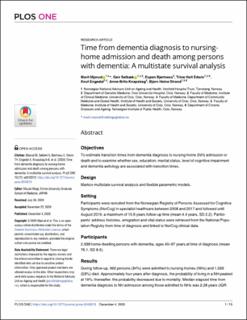| dc.description.abstract | Objectives: To estimate transition times from dementia diagnosis to nursing-home (NH) admission or death and to examine whether sex, education, marital status, level of cognitive impairment and dementia aetiology are associated with transition times. Design: Markov multistate survival analysis and flexible parametric models. Setting: Participants were recruited from the Norwegian Registry of Persons Assessed for Cognitive Symptoms (NorCog) in specialist healthcare between 2008 and 2017 and followed until August 2019, a maximum of 10.6 years follow-up time (mean 4.4 years, SD 2.2). Participants’ address histories, emigration and vital status were retrieved from the National Population Registry from time of diagnosis and linked to NorCog clinical data. Participants 2,938 home-dwelling persons with dementia, ages 40–97 years at time of diagnosis (mean 76.1, SD 8.5). Results: During follow-up, 992 persons (34%) were admitted to nursing-homes (NHs) and 1,556 (53%) died. Approximately four years after diagnosis, the probability of living in a NH peaked at 19%; thereafter, the probability decreased due to mortality. Median elapsed time from dementia diagnosis to NH admission among those admitted to NHs was 2.28 years (IQR 2.32). The probability of NH admission was greater for women than men due to women´s lower mortality rate. Persons living alone, particularly men, had a higher probability of NH admission than cohabitants. Age, dementia aetiology and severity of cognitive impairment at time of diagnosis did not influence the probability of NH admission. Those with fewer than 10 years of education had a lower probability of NH admission than those with 10 years or more, and this was independent of the excess mortality in the less-educated group. Conclusion: Four years after diagnosis, half of the participants still lived at home, while NH residency peaked at 19%. Those with fewer than 10 years of education were less often admitted to NH. | |
